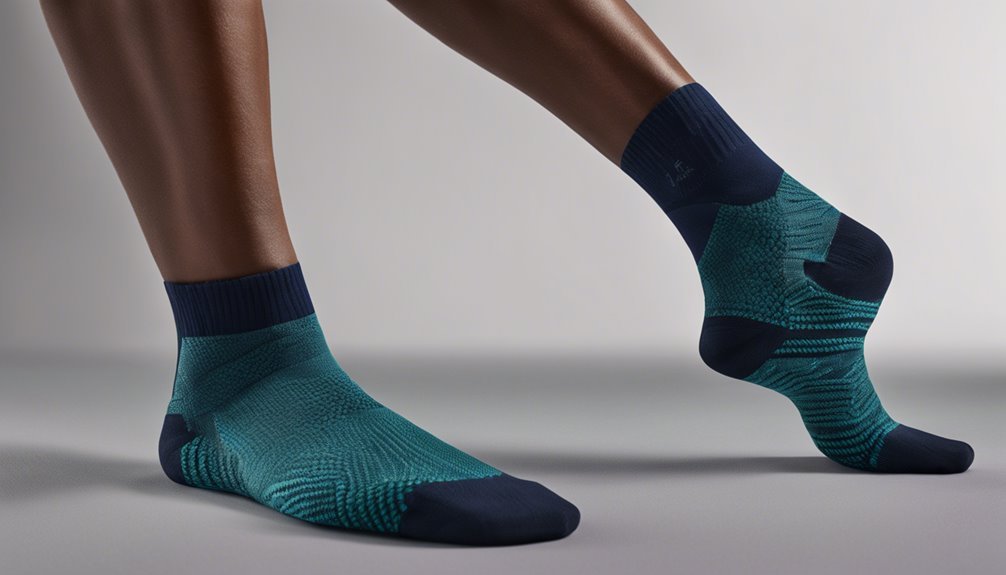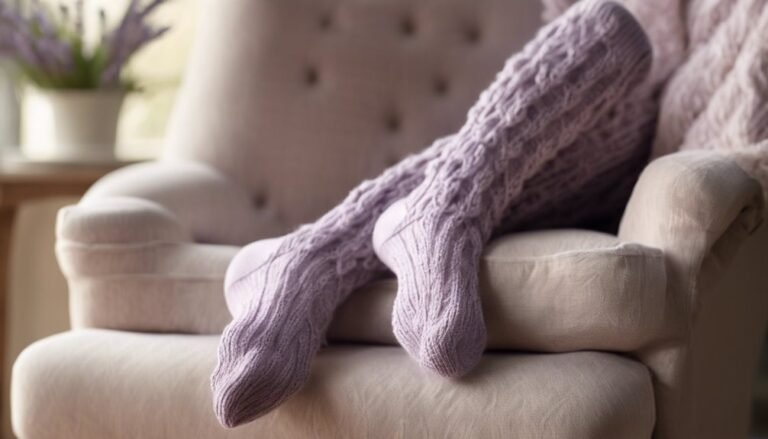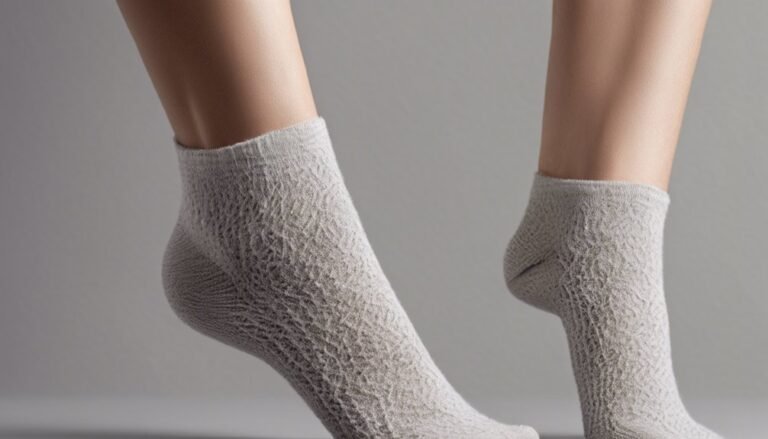How Socks Can Help With Achilles Tendon Pain
Wearing the right socks can greatly help with your Achilles tendon pain. Compression socks improve circulation and reduce swelling, providing targeted support to alleviate discomfort. Moisture-wicking materials keep your feet dry, minimizing the risk of blisters. Additionally, supportive designs can offer arch support, cushioning, and stability to reduce strain on the tendon. Choosing the right sock enhances mobility and comfort, making a noticeable difference. Discover more ways to ease your discomfort as you continue to explore solutions.
Understanding Achilles Tendon Pain

Achilles tendon pain, often characterized by discomfort along the back of the heel, can substantially impact your mobility and quality of life. The primary causes of pain include overuse, improper footwear, and biomechanical issues such as flat feet or high arches. Understanding these causes is essential for effective management. To prevent this pain, consider implementing specific strategies like gradually increasing physical activity, ensuring proper warm-up routines, and choosing supportive footwear. Stretching exercises for the calf muscles can also enhance flexibility and reduce strain on the tendon. By recognizing the risk factors and employing these prevention strategies, you can promote tendon health and maintain your freedom of movement, allowing you to engage in daily activities without discomfort.
The Role of Compression Socks
When managing Achilles tendon pain, incorporating compression socks into your routine can provide significant benefits. These specially designed socks utilize advanced sock technology to deliver targeted compression, which can reduce swelling and improve circulation. By promoting blood flow, you may experience enhanced recovery and reduced discomfort.
| Compression Benefits | Sock Technology |
|---|---|
| Reduces swelling | Graduated compression |
| Enhances blood circulation | Breathable materials |
| Supports tendon recovery | Anatomical fit |
| Prevents muscle fatigue | Moisture-wicking properties |
Incorporating compression socks can empower you to move more freely while addressing the discomfort associated with Achilles tendon issues. Embrace the freedom that comes with effective support and improved recovery.
Benefits of Moisture-Wicking Materials
Moisture-wicking materials play an essential role in enhancing comfort and performance during physical activities. These fabrics actively pull sweat away from your skin, promoting moisture control and reducing the risk of blisters and irritation. When you're engaged in physical activity, maintaining a dry environment around your feet is fundamental, especially if you're dealing with Achilles tendon pain. By keeping your feet dry, moisture-wicking socks contribute to overall comfort enhancement, allowing you to focus on your performance rather than discomfort. Additionally, these materials often dry quickly, ensuring that your socks remain lightweight and breathable. This can be particularly beneficial during extended periods of activity, fostering a more enjoyable experience and supporting your body's natural movement without unnecessary distractions.
Supportive Sock Designs for Healing

Choosing the right sock design can greatly impact the healing process for those suffering from Achilles tendon pain. Supportive sock designs incorporate advanced sock technologies and supportive features, promoting comfort and recovery. Consider these elements when selecting your socks:
- Arch Support: Provides stability to minimize strain on the Achilles tendon.
- Compression Zones: Enhances blood flow and reduces swelling.
- Padding in Key Areas: Offers cushioning to alleviate pressure and friction.
- Moisture-Wicking Fabrics: Keeps your feet dry, preventing blisters and irritation.
Tips for Choosing the Right Socks
Although selecting the right socks may seem minor, it plays an essential role in managing Achilles tendon pain. Start by considering sock thickness; thicker socks can provide additional cushioning, which helps absorb impact and reduce strain on your Achilles. However, make sure they fit well to prevent bunching, which can lead to discomfort.
When it comes to sock materials, opt for moisture-wicking fabrics like merino wool or synthetic blends. These materials keep your feet dry, reducing the risk of blisters and irritation. Look for socks with graduated compression features, as they can improve blood circulation, further alleviating pain. Prioritize comfort and support in your sock choice, as they can notably enhance your mobility and overall well-being.
Frequently Asked Questions
Can Regular Socks Worsen Achilles Tendon Pain?
Yes, regular socks can worsen Achilles tendon pain if they're made from inappropriate material or if their thickness doesn't provide adequate support. Choosing socks designed for comfort and support can greatly alleviate discomfort during activities.
How Long Should I Wear Supportive Socks Daily?
You should aim for daily wear of supportive socks for several hours, ideally matching your activity level. Different sock types, like compression or arch support, can enhance comfort and stability, promoting overall foot health and freedom of movement.
Are There Specific Socks for Athletes With Achilles Issues?
You'd think ordinary socks could suffice, but athletes need specialized ones. Compression benefits from high-tech sock materials support the Achilles, enhancing recovery and performance. Choosing the right socks lets you enjoy movement without unnecessary pain.
Can Socks Replace Other Treatments for Achilles Tendon Pain?
Socks can't replace traditional treatment alternatives for Achilles tendon pain, but their benefits include providing support and compression. They should complement other therapies, enhancing recovery while promoting comfort during activities to maintain your freedom of movement.
Is It Safe to Sleep With Compression Socks On?
Sleeping with compression socks can be a cozy embrace for your legs, enhancing circulation and providing compression benefits. However, make certain they're not too tight; sleep safety is paramount in avoiding discomfort or restricted blood flow.







